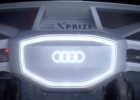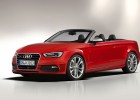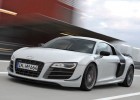Audi at the 2012 Worthersee Tour
Audi is exhibiting concept vehicles for lifestyle, action and sport on the Wörthersee Tour. Three powerful versions provide new accents in the Q3 model family, and with its e-bike Wörthersee prototype Audi defines a technical bike concept that explores the limits of technical feasibility on the basis of Audi’s core competences “design”, “ultra”, “connect” and “e-tron”.
This grand meeting of Audi, VW, Seat and Skoda fans is being held for the 31st time from May 16 to 19 in Reifnitz, on the Wörthersee in Carinthia, Austria.
– Three Audi Q3 themed cars
– Audi e-bike Wörthersee: high-end sports equipment for stunts
– 16 production Audi models on 3,500 square meters of stand area
A center of focus for Audi at this year’s Wörthersee Tour are the three Q3-based themed cars: the new Audi Q3 red track, the Audi Q3 jinlong yufeng or ‘Golden Dragon in the Wind’ and the Audi RS Q3 concept. All three add new but quite different aspects to the character of this compact SUV: leisure-oriented, sturdy, dynamic. They are powered by five-cylinder TFSI engines developing between 228 kW (310 hp) and 265 kW (360 hp).
The Audi Q3 red track will appeal to winter-sport enthusiasts. On its roof it carries two pairs of Audi skis made from carbon fiber-reinforced polymer. Stored in the load area are two hand lamps with radiant heating elements and a thermos flask, all supplied inductively with electric power. Heatable seat cushions are integrated into the reversible load-area mat.
This concept car has an Energy Red paint finish that has been given additional luster by golden pearl-effect particles. Add-on body elements are finished in matt grey quartz paint; some of these items will soon be appearing in the Audi accessories program. In the Singleframe radiator grille the aluminum struts are vertical and red panels partially blank off the air inlets. The high-gloss package accentuates the window areas. Two compact LED headlights are installed in the roof rack and back up the beams from the xenon headlights after dark. The tailpipes of the dual-branch exhaust system are integrated into the rear diffuser. Inside the headlights the zones in the lower part of the daytime running light strips are painted in the body color.
Inside the Audi Q3 red track the dominant colors are black, grey and red. The seats are upholstered in an innovative combination of leather and cloth: Narrow strips of leather only a few tenths of a millimeter in width are woven together with the yarn. Smaller segments of the upholstery are made from Velvet leather, a strong material that is given a fascinating appearance and feel by a special treatment process. The large inlays make use of a three-dimensional stainless steel mesh.
The Audi Q3 red track features a powerful engine: the turbocharged five-cylinder TFSI with a displacement of 2.5 liters, a power output of 250 kW (340 hp) and a maximum torque of 450 Nm (331.90 lb-ft). With this power and torque, the Q3 red track accelerates from 0 to 100 km/h in 5.4 seconds and reaches a top speed of 263 km/h (163.42 mph). A 7-speed S tronic transmission and quattro permanent all-wheel drive deliver the power to all four road wheels. The 20-inch wheels are fitted with size 255/45 offroad tires. Compared with the standard Q3 model the front and rear tracks are both 40 mm (1.57 in) wider and the ground clearance has been increased by 30 mm (1.18 in).
Only a few weeks ago the Audi Q3 jinlong yufeng (Golden Dragon in the Wind) and the Audi RS Q3 concept made their debut at the Auto China exhibition in Peking. The Audi Q3 jinlong yufeng, with a brilliant Liuli Yellow paint finish and yellow interior decor, conjures up a close link with windsurfing. Its 2.5 TFSI engine has an output of 228 kW (310 hp).
Even more power is available in the RS Q3 concept: Its 2.5 TFSI engine develops 265 kW (360 hp) – top performance for maximum dynamism. The body, with its flared wheel arches and blue paint finish, has been lowered by 25 mm (0.98 in). The add-on body elements are made from carbon fiber-reinforced polymer, with either a black or a blue lacquered finish. The individual honeycombs in the Singleframe grille are slightly offset. Inside the car, a cool black finish has been adopted. The seats have sport seat cushions and backs with the integral head restraints that are normally reserved for the S sport seats.
One of the highlights on the Audi stand is the bicycle technology concept known as the Audi e-bike Wörthersee – a sport bike that does not fit into any of the usual categories. It is neither a pedelec nor a conventional bike, but is best described as a high-end pedelec made by Audi for sport, fun and tricks. The Audi e-bike Wörthersee combines the Audi brand’s principal competences – design, ultra, connect and e-tron – and explores the limits of what is technically feasible in terms of design, lightweight construction, networking and electric mobility.
This show bike is futuristic at the very first glance – a bike for tomorrow and beyond. All its components, even the pedals, have been shaped by Audi’s designers, for instance the 26-inch wheels made from CFRP that weigh only 600 grams (1.32 lb) each and have innovative large-area blade-pattern spokes.
The Audi e-bike Wörthersee’s ultra-light carbon-fiber frame weighs only 1,600 grams (3.53 lb). It makes use of bionic principles derived from nature. Material reinforcements are needed only at the points where loads actually occur. The swinging arm for the rear wheel is also made of CFRP. All in all, the Audi e-bike Wörthersee represents the full extent of the brand’s expertise in ultra-lightweight design.
The rear wheel is driven by a chain. The electric motor is a permanent magnet synchronous machine; it is located at the lowest point on the frame and drives the bottom bracket shaft directly. Maximum torque at the rear wheel is in the region of 250 Nm (184.39 lb-ft). Peak output from the electric motor is 2.3 kW – a new top value on the e-bike scene. The complete bicycle weighs only 21 kg (46.30 lb), equivalent to a power-weight ratio of 9 kg (19.84 lb) per kilowatt, or 7 kg (15.43 lb) per horsepower – another record-breaking value.
The lithium-ion battery is housed in the frame; it weighs about 5 kg (11.02 lb) and operates at a voltage of 48 V. Its capacity is 530 Wh and it can be fully recharged from a 230 V supply in two and a half hours. As an alternative it can be easily detached from the bike and replaced by a recharged battery.
The rider of the Audi e-bike Wörthersee can choose between five programs; these either support use of the pedals or permit electric-only travel.
In the ‘Pure’ mode the rider only propels the bike by means of the pedals. In the ‘Pedelec’ mode the rider is assisted by the electric motor; a top speed of up to 80 km/h (50 mph) can be reached and the action radius is between 50 and 70 kilometers (31 and 44 miles). In the ‘eGrip’ program the Audi e-bike Wörthersee can be ridden with the electric motor providing all the necessary power; in this case at speeds up to 50 km/h (31 mph). The rider controls the power output from the electric motor at a twistgrip and can configure it at the on-board computer.
In ‘Wheelie’ mode the power flow is electronically controlled in order to assist the rider when the front wheel is in the air. Alternative operating modes are available, and can be selected by smartphone or directly at the e-bike: either ‘Power Wheelie’ with an adjustable wheelie angle for less skilled riders, or ‘Balanced Wheelie’ for those with more experience. In the latter mode the rider’s balance is maintained electronically: as his or her weight is displaced forward or back, this is counteracted by either braking or accelerating the electric motor.
In this way the rider can influence the speed when riding on the rear wheel only by shifting his or her weight. Leaning forward speeds up the bike, leaning back slows it down. If the rider wants to use the pedals and maintain a constant power input, the training mode can be chosen. The electric motor then makes good the extra power needed when riding into the wind or up a hill, so that the rider’s performance can be kept constant for training purposes.
The Audi e-bike Wörthersee has a varied specification. The nine-speed hydraulically actuated gear shift has a very rapid sequential action, similar to the R tronic transmission in an Audi R8. The two disk brakes are also applied hydraulically. Seat height can be continuously adjusted at a handlebar control, even while the bike is being ridden. The front fork uses the more complex ‘upside-down’ principle; it is air-sprung, with 130 mm (5.12 in) of travel. LEDs are used for powerful lighting: the front light is integrated into the handlebar, the rear light into the seat.
The on-board computer is located in the frame top tube and operated using a touchscreen. Among the functions it provides are riding mode selection, recording trick sequences and adjustment of various e-bike functions such as electric pedaling assistance and lighting. The display shows road speed, distance covered, state of battery charge, energy consumption and slope angle at any given moment.
The rider’s smartphone communicates by WLAN with the bike’s computer. The antenna is integrated into the front brake line. To ride the bike, the immobilizer is deactivated at the smartphone; the bike is then ready for use. In addition, by way of the interface between the bike’s computer and the smartphone, video images recorded while riding or even complete trick sequences can be transmitted to the Internet or the trainer. Every trick performed successfully qualifies for success points. As the number of points increases, the rider is rewarded and at the same time the challenge level rises. The total Internet ranking can be compared with friends or other riders. The rider can locate them by way of Facebook entries that can be shown on the Audi e-bike Wörthersee’s display.
Source: Audi




















